Begonias belong to the genus Begonia which contains over 1,300 species of annuals, perennials, climbers, and shrubs. They can be divided into 7 groups: cane-like, rex-cultorum, rhizomatous, semperflorens, scandent or trailing, shrub-like, and tuberous.
Of these 7 groups, the most popular flowering types are semperflorens (wax-leaf Begonias) and tuberous (tuberous Begonias). These are grown as annuals in colder climates, and their unique and interesting flowers and foliage make them popular among gardeners as container plants in patios or for shady borders.
History
First recorded in Mexico as early as the 1500s, Begonias have since been discovered in sub-tropical climates worldwide except for Australia. Begonias were named as a tribute to Micheal Bégon (1638–1710), a governor of French Canada and patron of Botany.
Today there are over 10,000 recorded varieties and cultivars, most of which belong to the groups rhizomatous, semperflorens, or tuberous. Many Begonias have no flowers and are prized instead for their striking and unusual leaves. However, flowering types have proven to be firm favorites both in the gardening and houseplant communities.
Flowers can be red, pink, yellow, orange, and white and come in many different forms such as rose-like, rose-form, single or double forms, banded or ruffled petals, and many more!
Plant Facts
| Scientific name | Begonia spp. |
| Common names | Begonia, Wax-leaf Begonia, Tuberous Begonia, Bedding Begonia, Cane-like Begonia, Rhizomatous Begonia |
| Genus | Begonia |
| Family | Begoniaceae |
| Height | 0 ft. 5 in. – 10 ft. 0 in. |
| Width | 0 ft. 5 in. – 1 ft. 5 in. |
| USDA Plant Hardiness Zone | 9a, 9b, 10a, 10b, 11a, 11b |
| Origin | Subtropics except for Australia |
| Flower colors | Red, Pink, White, Yellow, Orange |
| Blooming season | Spring, Summer, Fall, Winter (dependent on variety) |
| Plant/Flower special features | Interesting foliage and blooms |
How to Plant and Grow Begonia Flower
Depending on the type, Begonia flowers have different needs when being grown in the garden. Most tuberous Begonias are more suitable for container and hanging basket planting, whereas wax-leaf and hardy tuberous types are preferred for beds and borders. These varieties bloom from summer to fall.
Cane-stemmed types can be grown outdoors in milder climates and bloom time differs between species; rex-cultorum types are usually grown as patio plants. Rhizomatous Begonias suit being grown in both beds or containers depending on climate, and flower from late winter to spring.
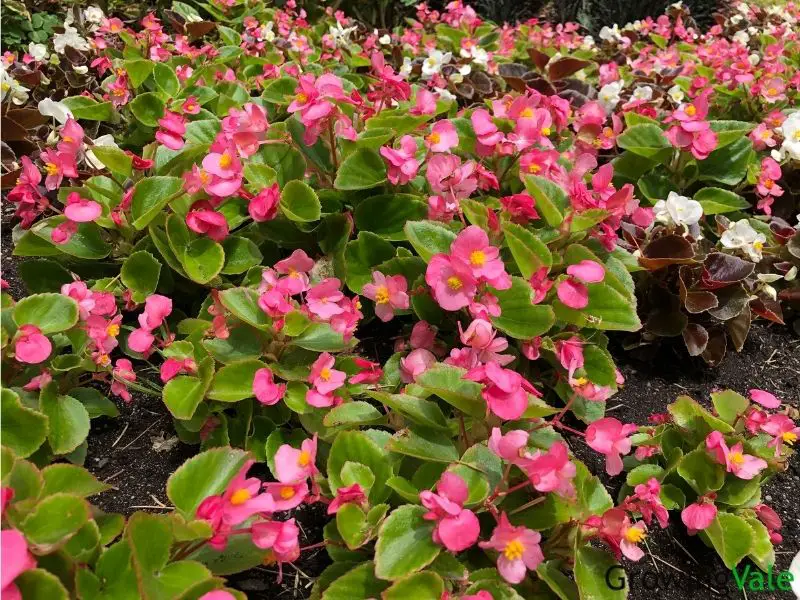
Growing Begonia Flowers in Beds
To grow Begonias in beds, ensure the site has the correct soil and light conditions and is somewhat sheltered from strong winds. Amend the soil if needed and prepare the bed by spading to a depth of 6-10 inches.
Plants started indoors should be hardened off and planted after the risk of frost has passed. Dig holes large enough to house the roots and plant with the top of the roots just below the soil line. Space plants at least 8 inches apart for dwarf varieties and 12 inches apart for normal varieties. Water well to settle in. To promote better branching, pinch off any buds or flowers when planting.
Growing Begonia Bulbs and Plants in Pots
To grow Begonias in containers, follow the recommendations for bed planting, but use a fertile, well-draining potting mix and space plants closer together for a more attractive display. Ensure your pot is large enough and has sufficient drainage holes.
For tuberous Begonia plants, start overwintered or purchased bulbs into growth in February (June blooming) or March-April (July blooming) at 64°F. Place the tubers hollow side up and 1 inch deep, in a tray of moist, sandy, potting mix.
Keep the potting mix moist but not wet, and place it in an area with indirect light at 70°F. After one month they will be ready for transplantation to a larger container. Make sure not to overwater as these plants are susceptible to root rot. They will need to be hardened off two weeks before the last frost. Plant them outside in their containers or hanging baskets in groups of 3-4 tubers.
In milder climates where the weather is warm and humid, cane-stemmed varieties can be grown outdoors. Plant them in a loose, well-draining potting mix, in a container that dries out quickly. Water regularly but don’t leave them in standing water. These plants may require staking if they are tall varieties.
If growing rhizomatous Begonias in a container, choose a variety that does not require a large amount of space and won’t spread too wide. Choose a shallow container, preferably made of clay, and fill with a coarse, well-draining potting mix. During the spring to fall growing season, allow the soil to fully dry out in between waterings, and in winter water sparingly until normal growth resumes.

Overwintering Begonia Plants
In colder climates, Begonias in containers can be overwintered. Place pots in an area with bright, filtered light but be wary of those previously grown in shady areas as they could get burned. To combat the dry air in the house, place containers on pebble trays to increase the humidity. Keep the soil lightly moist and fertilize plants regularly.
Tuberous Begonias go dormant during winter, but bulbs can be dug up and re-started the following year. They need to be lifted before the first winter frost and stored at 45°F in a dry, frost-free area such as a garden shed. They should be kept in barely moist soil and watered sparingly to stop them from completely drying out.
Hardy tuberous Begonias can be left year-round in the ground in milder climates if they are planted against a warm, south-facing wall and mulched in early winter for extra warmth.

How to Propagate Begonias
Begonias can be propagated through a variety of methods such as tuber division, rhizome division, stem, leaf, or root cuttings, or from seed. The method chosen will be dependent on plant type.
Propagation through Division
To divide tuberous Begonia flowers, start plants as usual, and once shoots have emerged, use a sharp knife to divide tubers. Ensure each section has at least one growth bud and roots. Leave for a few hours to develop a callus, then transfer to pots, leaving the tubers in line with the compost surface.
For the division of rhizomatous types, use a clean, sharp knife and cut rhizomes into 1-2 inch sections. Ensure there is at least one growing bud or leaf scar on each new section. Place the section horizontally, half-buried in the soil of the new location.
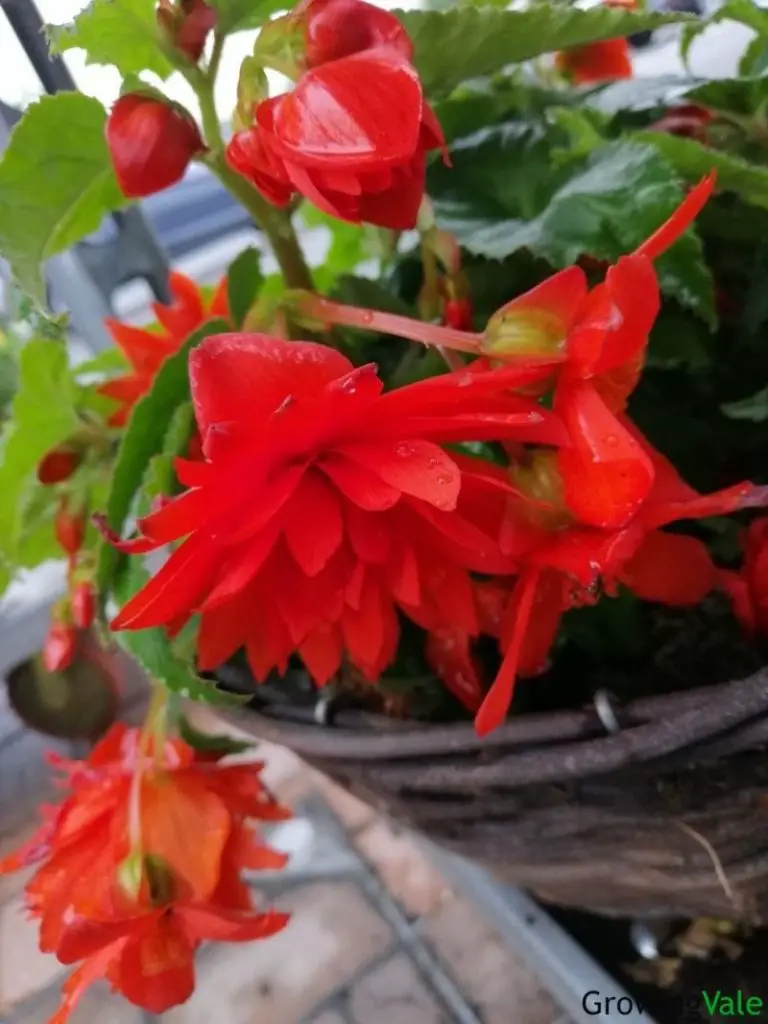
Propagation from Cuttings
To propagate from stem cuttings, in April, take 4-inch cuttings leaving the top leaves only, and insert them into a sandy rooting mix with a consistent bottom temperature of 64-70°F. Space cuttings out in the soil to reduce the risk of fungal problems.
This method is recommended for tuberous, cane-stemmed, and some wax-leaf types. With tuberous types, ensure cuttings have a heel (section of tuber). Short cane-stemmed varieties are usually better suited to being grown from root or leaf cuttings.
For leaf cuttings take a large leaf and cut using a sharp knife, making sure each of the main veins on the underside has been cut through. Place the leaf section horizontally, with one-third of the bottom section of the leaf in the rooting medium. Cover with a plastic lid to keep humidity levels high and take care not to overwater.
Within 3-4 weeks, new plantlets should have formed from where the veins have been cut, and be ready for transplantation to a container with a suitable potting mix.
Propagation from Seeds
Wax Begonias can be propagated by seed in February or March, except for double-flowered cultivars which are generally propagated through cuttings. Seeds are small and delicate and should be handled gently.
Sow seeds onto a tray of seed compost and press down lightly into the soil. Mist with water then cover with a plastic lid. Place them 6 inches under a fluorescent light for 14 hours a day and keep the temperature maintained at 73–80°F.
Seedlings may take up to a month to germinate. When the first true leaves have emerged, gently transplant them into bigger 3-inch pots and then again later on into 5-inch pots.
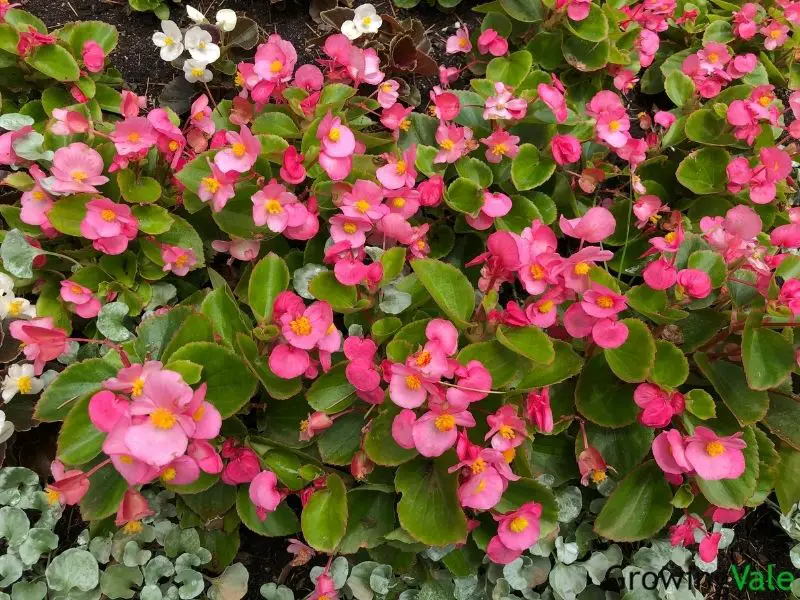
Care and Maintenance
Here’s how to care for begonias:
Soil
Most Begonia plants prefer moist, organic, well-draining soil. Amend clay and sandy soil types with organic matter such as pine bark humus or well-rotted manure to improve aeration and water retention properties. Wax-leaf Begonias can tolerate moderately fertile soils as long as it is well-draining.
Water
These plants benefit from regular watering, especially during the growing season. The soil should be kept consistently moist, however, take care not to over-water as Begonias won’t tolerate water-logged soils and are susceptible to root rot. Water around the base of the plant and take care not to wet foliage. From August, begin reducing the watering of tuberous Begonias to prepare them for winter dormancy.
Wax-leaf types can survive a little neglect as they are drought tolerant thanks to their thick, waxy leaves retaining moisture. Other Begonias on the other hand cannot tolerate dry soils, and these conditions will lead to thinning and unattractive foliage.
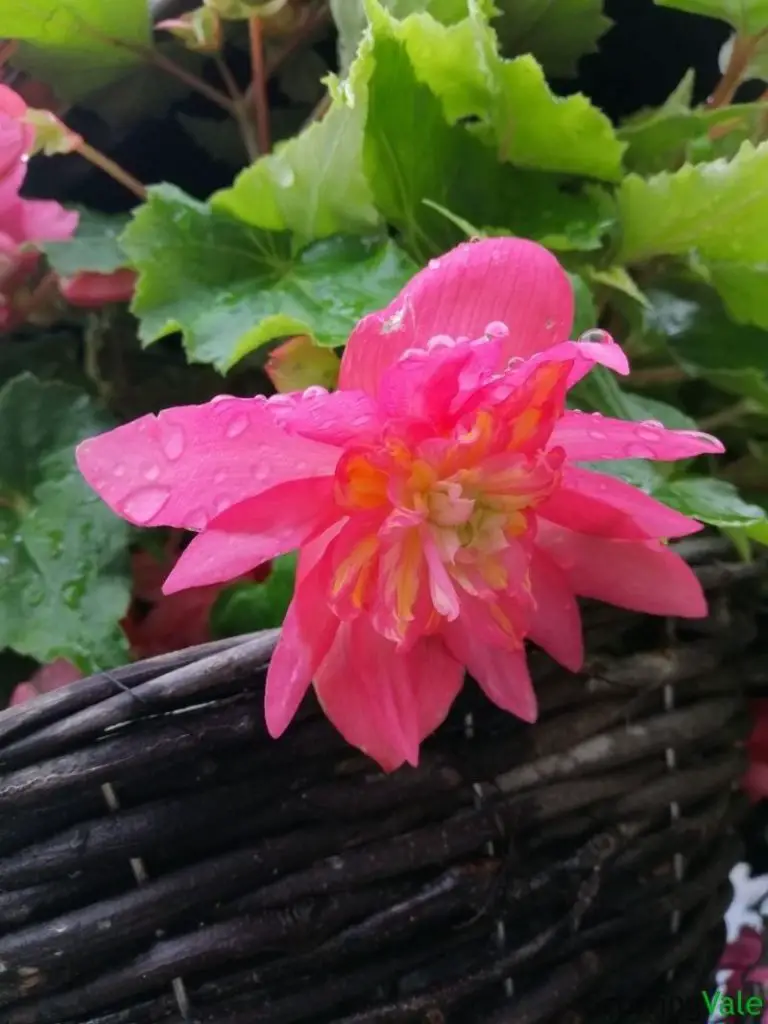
Fertilizer
Regularly fertilize plants during the growing season (spring to fall) using a liquid fertilizer at half the strength recommended, but twice as often. Regular fertilization will increase the number of flowers produced. From August, stop fertilizing tuberous types to prepare for the winter dormancy period.
Mulching is recommended as this will provide nutrients while helping to retain moisture in the soil.
Sunlight
All Begonia flowers prefer partial or dappled shade. Wax-leaf and cane-stemmed plants can tolerate more sunshine than other types, whereas rhizomatous and rex types prefer more shade. In hotter climates, too much sun can lead to burned foliage, and in colder climates, too little shade will result in fewer flowers.
Temperature and Humidity
Begonia plants are hardy to USDA zones 9-11 so are usually grown as annuals in colder climates or overwintered indoors.
The ideal temperature is 60-80°F, however depending on variety, some species can withstand temperatures as high as 100°F, and as low as 40°F. Tuberous types are sensitive to high heat and humidity and rhizomatous types prefer cooler temperatures between 58-70°F.
Pest and diseases
Begonias are susceptible to powdery mildew, Botrytis, and occasionally Phytophthora root rot. Ensuring good soil drainage, and spacing plants far enough apart to allow good airflow are good prevention methods. Prune away any leaves infected with Botrytis.
It is good practice to regularly scout plants for signs of mealybugs, aphids, spider mites, thrips, whiteflies, and slugs and snails.
Pruning
Most Begonias don’t require pruning, however, those grown in containers as perennials should be cut back one-third after flowering before they are overwintered.
Tall growing species such as the cane-stemmed Angel Wing Begonia may need to be pruned to keep it at a manageable size as they can reach up to 10 feet tall under certain conditions. These Begonia plants will also benefit from pruning to encourage bushier growth.
Toxicity
Begonias contain oxalates which make them toxic to cats or dogs if ingested. Although classified as non-toxic to humans, proper research and consultation with a medical professional is advised before attempting to use these plants for consumption or otherwise.
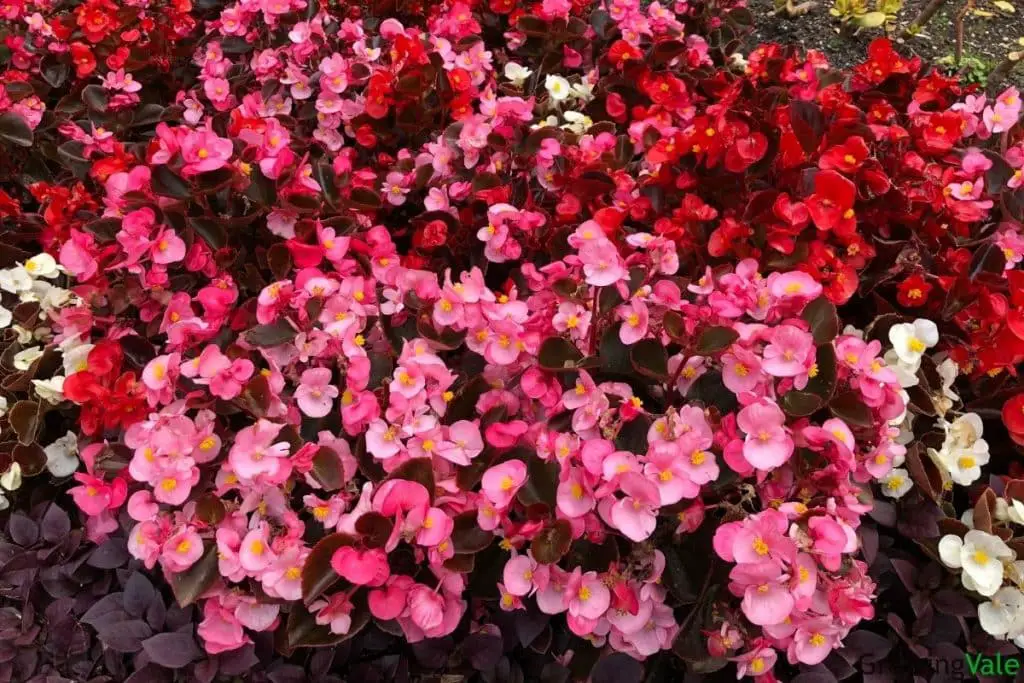
Uses of Begonias
Begonias are extremely popular as ornamentals worldwide, as they have versatility in being both outdoor and indoor plants. Their diversity as not only flowering plants but also as foliage lends them to be suitable for garden beds, borders, hanging baskets, containers, and more.
They have also been used worldwide in cooking and for medicinal purposes. In India, Indonesia, Japan, and Myanmar Begonia leaves are used as potherbs for flavoring. They are a favorite snack among children in China and Northern Mexico, and in some rural areas, the sap is even used to curdle milk for making cheese.
In The West Indies, Begonias have been used in teas to treat colds, and are even used by herbalists to treat cancer due to their anti-tumor properties. All parts of the plant have a use; roots and tubers are used as purgatives, the sap is used to treat wounds and toothache, shoots treat upset stomachs, and leaves are used for concoctions. Worldwide, Begonias plants have standing in traditional medicine.
Common Varieties and Cultivars
Below are some of the most popular flowering Begonia varieties and cultivars:
- (Begonia x corallina) Angel Wing Begonia – cane-stemmed type with large dark green leaves speckled with silver. Flowers can be red, orange, pink, or white. Great in containers.
- (B. solananthera) Brazilian Heart – scandent type with fragrant, delicate, white flowers. Perfect for hanging baskets.
- Begonia Cocktail Brandy – a compact wax-leaf type with bronze-green leaves and pale pink flowers. Looks fantastic in shady borders.
- Begonia Hanging Basket Apricot – a tuberous Begonias which is perfect for hanging baskets. It has large, rose-form apricot flowers that can reach up to 5 inches wide.
- Begonia Picotee Flamenco – a colorful tuberous cultivar, with red and white mottled rose-form flowers that grow up to 8 inches wide. Perfect in window boxes and hanging baskets.
Conclusion
Begonias are a group of over 1,300 species of plants which can be further divided into 7 groups. Of these, the most popular and numerous garden varieties are tuberous, wax-leaf, and rhizomatous. These shade-loving plants are perfect for shady borders and container growing.
Propagation can be done using a variety of methods dependent on variety. In milder climates, some species may be left outdoors year-round, but in general, they are grown as annuals, or containers are overwintered indoors.
Across the globe, Begonia plants are used either in cooking or for their medicinal properties and are favorites among gardeners and home owners for their exotic and interesting flowers and foliage.
See more: Begonia Flower Meaning and Symbolism
*References
Reference list:
ACS Distance Education, Begonias
https://www.acs.edu.au/info/horticulture/plants/begonias.aspx
American Begonia Society, Cane-like Begonias: Like Bamboo with Flowers
https://www.begonias.org/Articles/Vol47/CaneLikeBegonias.htm
NC State Extension, Begonia (Semperflorens-Cultorum Group),
https://plants.ces.ncsu.edu/plants/begonia-semperflorens-cultorum-group/
S. Rajbhandary. (2013). Traditional Uses of Begonia Species (Begoniacae) in Nepal,
”Close”

